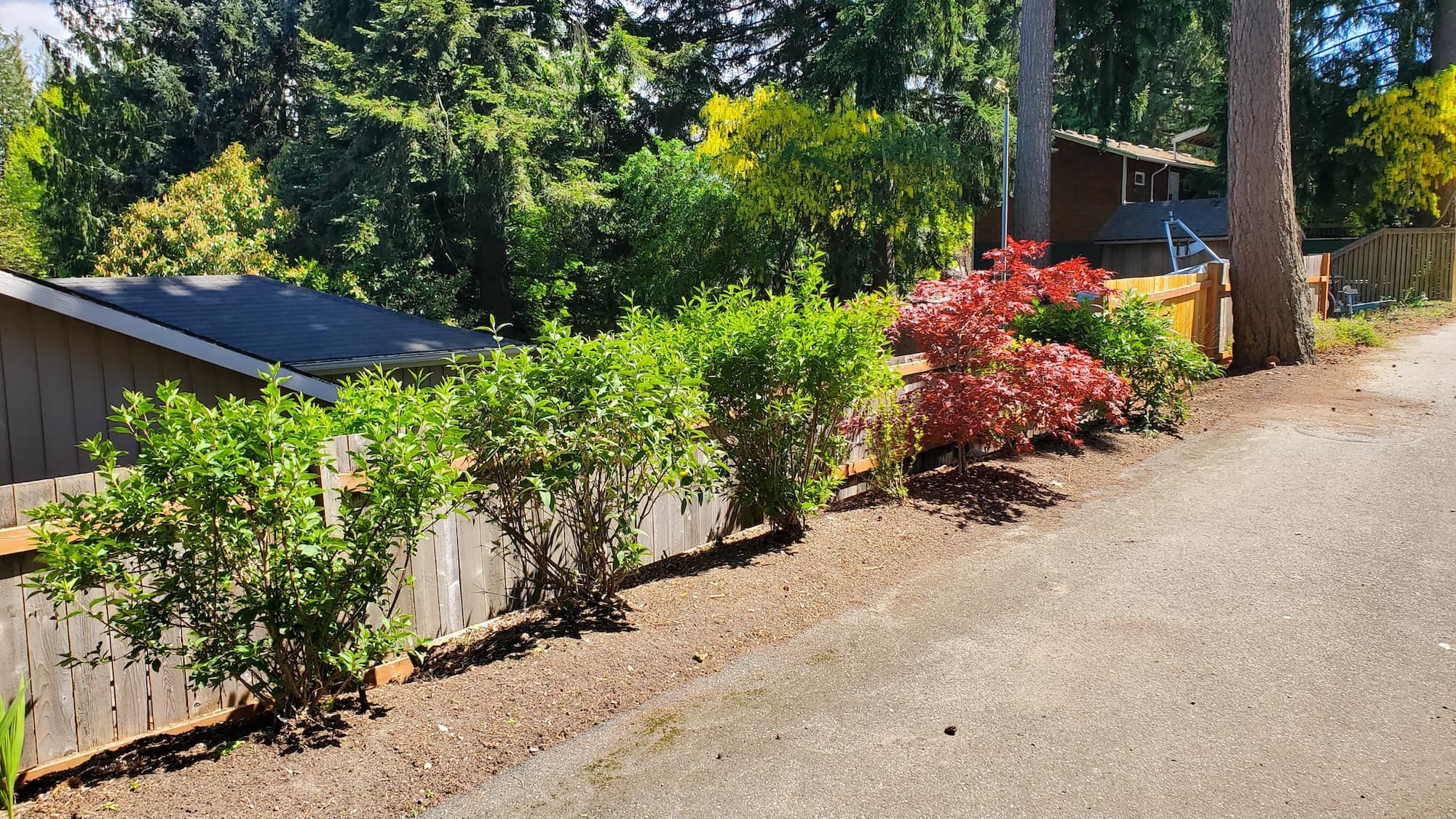West Seattle Flowering shrub seasonal trim
Homeowner’s Issue
West Seattle yards face a mix of conditions that drive how and when shrubs should be cut back. Our neighborhood has long, wet winters and short dry summers; many yards sit on compacted glacial loam or thin topsoil over clay, and steep lots on High Point, Admiral, and parts of Fauntleroy shed water quickly or hold soggy pockets. Large cedars and maples cast deep shade along ravines toward Lincoln Park and Alki, encouraging moss, ivy, and evergreen salal to creep into shrub beds. At the same time, south- and west-facing exposures get intense late-afternoon sun in July-August, which stresses newly cut stems if you prune at the wrong time.
Homeowners call us when shrubs block sightlines, rub against siding, or bloom poorly because dead wood and crowded centers choke air and light. HOA rules on sightlines and tidy front yards are common on the higher streets and near business corridors like California Ave SW — that increases demand for regular, predictable pruning. Sustainable care matters here: improper winter pruning can invite rot in our wet season; heavy-handed cuts on flowering shrubs can eliminate next season’s blooms. We plan cuts around each plant’s bloom cycle, improve soil structure with organic amendments, and use mulches that retain moisture without creating soggy crowns. The result is healthier plants, better curb appeal, and fewer surprise trips for emergency fixes after a windstorm.
Our Quality Service
We evaluate each shrub by species and bloom timing, then prune to preserve flowers and structure. We use sharpened bypass pruners, loppers, and hand saws, sanitize between plants, and favor selective thinning over shearing to keep natural form and improve air flow. For larger jobs we bring a battery-powered hedge trimmer and chipper; small jobs are quiet and can often be finished in a half day.
Workflows and timelines:
- Site visit and photo estimate within 3–5 business days.
- Typical service times: small yard 1–3 hours, medium 3–6 hours, large properties or multiple beds 1+ day.
- Seasonal timing: spring-flowering shrubs pruned immediately after bloom; summer-flowering shrubs pruned late winter/early spring.
Local insights: we adjust for West Seattle’s rainy season, slope runoff, and nearby tree shade. We never use herbicides; we limit soil disturbance, add organic compost as needed, and recommend water-wise mulches during summer advisories. Benefits include safer sightlines, longer-lasting blooms, lower maintenance between visits, and reduced disease pressure.
What’s Included
- Species-specific pruning to preserve next season’s blooms.
- Removal of dead wood, crossing branches, and inward growth.
- Clean-up: branch removal, light sweeping, and bed edging.
- Chipping of branches on-site where possible; haul-away available.
Options / Upgrades:
- Mulch + landscape fabric (if requested) for moisture retention and weed suppression.
- Organic soil amendment and topdressing.
- Green-bin composting vs. full haul-away.
- Plant replacement/infilling with pollinator-friendly species.
- Irrigation check and drip-line adjustments.
Before & After / Expectations
- Noise & mess: expect hand tools and occasional powered chipper; we stage work to minimize disturbance. Small piles of clippings will be present during work and removed the same day unless you choose on-site chipping.
- Access: clear a 3–4 ft path from driveway or street to shrub beds; parking nearby speeds the job.
- Debris handling: we offer chipping into reusable mulch, green-bin composting, or full haul-away. Let us know preference in the estimate.
- Timeline: most residential trims completed same day; larger estates may take 1–2 days with next-day cleanup.
- Post-service care: water newly exposed roots during dry spells (deep soak once a week in summer), monitor for resprouting in spring, and expect increased weed competition in spring—mulch and hand-weeding are sustainable controls. Avoid heavy pruning during February storms; prune after risk of severe wind once possible.
FAQs (3–5)
Q: When is the best time to prune my rhododendrons and azaleas?
A: Prune immediately after they finish blooming in spring to protect next year’s flower buds.Q: Do you use herbicides to control ivy and blackberries on ravine edges?
A: No. We remove invasive vines by hand, cut and root-remove where possible, and follow up with mulching and planting competitive natives.Q: How long before the yard looks “settled” after a large prune?
A: Most shrubs reshaped to natural form recover visibly within a season; expect fuller branching by next growing season when pruned correctly.Q: What if my property has steep slopes or limited parking?
A: We’ll note access challenges on the estimate. Steep sites may need additional time and equipment; we can stage materials to minimize neighborhood disruption.
Call to Action
West Seattle homeowners: book a seasonal trim timed for your shrubs’ bloom cycle and local microclimate. We offer quick scheduling, free photo estimates, and practical, sustainable pruning that keeps plants healthy and yards tidy — no herbicides, only sensible maintenance.
Email: neatandtidyseattle@gmail.com
Phone: 206-538-9344
Licensed • Bonded • Insured
Request a free estimate or send photos from Alki, Admiral, Lincoln Park, or your block on California Ave SW — we’ll reply with straightforward recommendations and a clear price.










